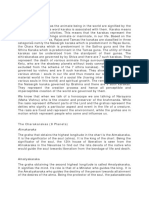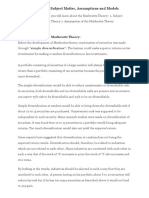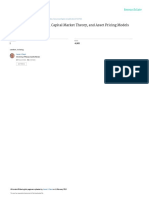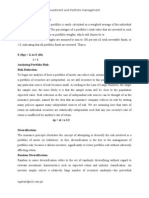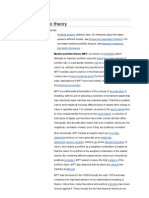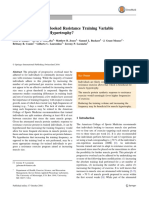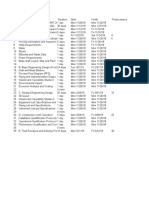In Other Words, Given The Choice Between Two Equally Risky Investments, An Investor Will
In Other Words, Given The Choice Between Two Equally Risky Investments, An Investor Will
Uploaded by
Oumer ShaffiCopyright:
Available Formats
In Other Words, Given The Choice Between Two Equally Risky Investments, An Investor Will
In Other Words, Given The Choice Between Two Equally Risky Investments, An Investor Will
Uploaded by
Oumer ShaffiOriginal Title
Copyright
Available Formats
Share this document
Did you find this document useful?
Is this content inappropriate?
Copyright:
Available Formats
In Other Words, Given The Choice Between Two Equally Risky Investments, An Investor Will
In Other Words, Given The Choice Between Two Equally Risky Investments, An Investor Will
Uploaded by
Oumer ShaffiCopyright:
Available Formats
Chapter Six, Investment Analysis and Portfolio Management (AcFn 3201), Jig-Jiga University. June, 2021.
(2013
E.C.)
CHAPTER SIX.
Portfolio Theory.
6.1. Diversification and portfolio risk.
A portfolio is simply a collection of financial assets involving investment tools such as bonds,
foreign exchange, stocks, gold, asset-backed securities, real estate certificates and bank deposits
which are held simultaneously by one person or a group of persons. In other word, Portfolio is a
collection of investment vehicles assembled to meet one or more investment goals.
If you own a home and household furnishings and a savings account you already have a
portfolio.
A portfolio can be either;
• Growth-Oriented Portfolio: primary objective is long-term price appreciation, or
• Income-Oriented Portfolio: primary objective is current dividend and interest income.
The ultimate goal of portfolio is to get an efficient portfolio. Efficient Portfolio is a portfolio
with maximum expected return for a given level of risk, or minimum risk for a given expected
return. In other words, given the choice between two equally risky investments, an investor will
chose the one with the highest potential return. And given the choice between two investments
offering the same return, an investor will choice the one that has the least risk.
Most investors do not hold stocks in isolation. Instead, they choose to hold a portfolio of several
stocks. When this is the case, a portion of an individual stock's risk can be
eliminated, i.e., diversified away. Or most portfolios are diversified to protect against the risk of
single securities or class of securities.
Portfolio theory was initially developed by Markowitz (1952) as a normative approach to
investment choice under uncertainty. There are two important assumptions of portfolio theory.
These are:
(a) The returns from investments are normally distributed. Therefore, two parameters, the
expected return and the standard deviation, are sufficient to describe the distribution of returns.
(b) Investors are risk averse (risk averse→ means that investors do not like risk and therefore,
demand more expected return if they take on more risk). Therefore, investors prefer the highest
expected return for a given standard deviation and the lowest standard deviation for a given
expected return.
Given these assumptions, it can be shown that it is rational for a utility-maximizing investor to
hold a well-diversified portfolio of investments. Suppose that an investor holds a portfolio of
securities. This investor will be concerned about the expected return and risk of the portfolio.
The expected return on a portfolio is a weighted average of the expected returns on the securities
in the portfolio.
The Modern Portfolio Theory (MPT) is appreciated by Scientists and it is the most practical
investment model ever introduced by Harry M. Markowitz.
The model and its components shall be fully introduced, also covering the mathematical
development of the model. Diversification is also one method of reducing risks and maximizing
returns by putting all of your investible funds in different investment alternatives.
JJU, COBE, Dep’t of ACFN, Compiled By Instructor;-
Page-- 1.
“Mahamedkeder Abdilahi Yusuf”.
Chapter Six, Investment Analysis and Portfolio Management (AcFn 3201), Jig-Jiga University. June, 2021. (2013
E.C.)
Diversification.
The risk of a portfolio depends not only on the risk nature of the securities making up the
portfolio but also on the relationship among the securities. In other words, the potential of an
asset to diversify a portfolio is dependent upon the degree of co-movement of returns of the asset
with those other assets that make up the portfolio i.e.;- In a simple, two-asset case, if the returns
of the two assets are perfectly negatively correlated it is possible (depending on the relative
weighting) to eliminate all portfolio risk. So, this must be considered in calculating the standard
deviation of a portfolio return.
Therefore, an investor can reduce relative risk by selecting securities that have little relationship
with each other. Diversification is the process of combining securities in a way that reduces total
risk without losing portfolio return.
Benefits from Diversification:
1) Perfect Positively Correlation: Here, there is a linear relationship between risk and
return. It is not possible to reduce risk without reducing return. There is no benefit from
diversification when returns of securities are perfect positively correlated.
2) Perfect Negative Correlation: Here one is referring to a Portfolio that has higher
expected return and lower risk. But, at the same level of expected return, the Portfolio
has no risk. Therefore, there are more benefits to be derived from diversification when
securities are negatively correlated.
3) Uncorrelated Returns: At the same level of expected returns, different Portfolios have
different levels of risk. As more assets with uncorrelated returns are included in the
portfolio, the benefit from diversification increases.
6.2. Portfolio Risk and return.
Risk is the probability of the losses one incurred on portfolio investment and the return is the
profit or benefit one derives from portfolio investment.
While there may be different definitions of risk, one widely-used measure is called variance.
Variance measures the variability of realized returns around an average level. The larger the
variance the higher the risk in the portfolio.
Example-1: Oliver’s portfolio holds security A, which returned 12.0% and security B, which
returned 15.0%.
At the beginning of the year 70% was invested in security A and the remaining 30% was
invested in security B.
Given a standard deviation of 10% for security A, 20% for security B and a correlation
coefficient of 0.5 between the two securities, calculate the portfolio variance.
s2 = WA2sA2 + WB2sB2 + 2WAWBsAsBrAB.
PortfolioVariance=(.72x 0.12) + (.32x 0.22) + (2x.7x.3x0.1x0.2x.5).
JJU, COBE, Dep’t of ACFN, Compiled By Instructor;-
Page-- 2.
“Mahamedkeder Abdilahi Yusuf”.
Chapter Six, Investment Analysis and Portfolio Management (AcFn 3201), Jig-Jiga University. June, 2021. (2013
E.C.)
= 0.0127.
Portfolio standard deviation is the square root of the portfolio variance.
s= √ 0.0127 = 0.1127 or 0.1127 X 100 = 11 .27 %.
On the other hand, portfolio return can be calculated as;
RP = W1R1 + W2R2 + W3R3 …………….
Example-2: Oliver’s portfolio holds security A, which returned 12.0%, security B, which
returned 15.0% and security C, which returned –5%.
At the beginning of the year 45% was invested in security A, 25.0% in security B and the
remaining 30% was invested in security C.
Calculate the return of Oliver’s portfolio over the year.
Rp = (.45 x 0.12) + (.25 x 0.15) + (.3 x (-5%)) = 0.0765 or 7.65%.
* note;- W – means weight or the proportion of the portfolio invested in the stocks.
6.3. Capital allocation between risky and risk free assets.
Capital allocation decision = choice of proportion to be invested in risk-free versus risky assets
Asset allocation decision = choice of type of assets to invest in (e.g., bonds, real estate, stocks,
foreign assets etc.)
Security selection decision = choice of which particular security to invest in.
Capital allocation decision may consider the following aspects:
examine risk/return tradeoff
demonstrate how different degrees of risk aversion will affect allocations between risky
and risk free assets
consider the optimal risky portfolio: as given and analyze the allocation decision between
“the” risky portfolio (treated as one asset) and the risk-free asset (T-bills).
Rate of return: P1-P0 + D1.
P0
Where, D1 = Annual income or dividend at the end of a given time period,
P1 = Closing security price at a given time period.
P0 = Opening security price at a given time period.
The Risk-Free Asset.
Technically, the risk-free asset is default-free and without inflation risk (a price-indexed
default-free bond)
in practice, Treasury bills come closest, because:
They are a Short term, means they have a little interest-rate or inflation risk.
Their Default risk is practically zero, since the government would no default.
Capital allocation also refers that an investor must decide how to invest all of his/her wealth and
has only two options: a risk-free asset such as Treasury Bills (T-Bills) and a risky portfolio of
stocks (such as a mutual fund).
JJU, COBE, Dep’t of ACFN, Compiled By Instructor;-
Page-- 3.
“Mahamedkeder Abdilahi Yusuf”.
Chapter Six, Investment Analysis and Portfolio Management (AcFn 3201), Jig-Jiga University. June, 2021. (2013
E.C.)
Since all of her/his wealth must be invested, the decision that she/he makes can be
summarized by one parameter, take “w” to be the fraction of her/his wealth that she/he
invests in the risky portfolio.
Since she/he must allocate all of her/his wealth to either the mutual fund or T-Bill, the
fraction of her/his wealth invested in T-Bill must be, 1 − w.
If we assume a functional form for the investors objective (or utility) function, then we
can determine the optimal fraction of wealth for the investor to put into the risky
portfolio, w.
6.4. Optimum risky portfolio.
6.4.1. The Optimal Portfolio.
The optimal portfolio concept falls under the modern portfolio theory.
The theory assumes (among other things) that investors fanatically try to minimize risk while
striving for the highest return possible.
The theory states that investors will act rationally, always making decisions aimed at maximizing
their return for their acceptable level of risk. The optimal portfolio shows us that it is possible for
different portfolios to have varying levels of risk and return.
Each investor must decide how much risk they can handle and then allocate (or diversify) their
portfolio according to this decision. The chart below illustrates how the optimal portfolio works.
The optimal-risk portfolio is usually determined to be somewhere in the middle of the curve
because as you go higher up the curve, you take on proportionately more risk for a lower
incremental return.
On the other end, low risk/low return portfolios are pointless because you can achieve a similar
return by investing in risk-free assets, like government securities.
You can choose how much volatility you are willing to bear in your portfolio by picking any
other point that falls on the efficient frontier. This will give you the maximum return for the
amount of risk you wish to accept. Optimizing your portfolio is not something you can calculate
in your head. There are computer programs that are dedicated to determining optimal portfolios
JJU, COBE, Dep’t of ACFN, Compiled By Instructor;-
Page-- 4.
“Mahamedkeder Abdilahi Yusuf”.
Chapter Six, Investment Analysis and Portfolio Management (AcFn 3201), Jig-Jiga University. June, 2021. (2013
E.C.)
by estimating hundreds (and sometimes thousands) of different expected returns for each given
amount of risk.
Optimal Portfolio Choice.
• Zero-Risk Portfolio: constant return portfolio.
• Efficient Portfolio: portfolio with maximum expected return for a given level of risk, or
minimum risk for a given expected return
• Efficient Frontier: collection of all efficient portfolios.
• Optimal Portfolio: collection of securities that provides an investor with the highest level
of expected utility
• Market Portfolio: all tradable assets.
6.4.2. Portfolios of Two Risky Assets.
If we wish to construct a portfolio with more than one risky asset, we still use the general utility
function approach described above.
However, the combination line indicating the expected return-variance combinations that can be
obtained with more than one risky asset is no longer linear.
We need to consider how portfolio variance changes as we change portfolio proportions.
Let us look at the simple case, where there are exactly two risky assets (or portfolios), D and E.
Then the expected return and variance of returns is given below:
We see below the combination line of the two risky assets, D and E.
Note that the portfolio standard deviation is less than the weighted average of the individual
standard deviations. Also, the slope of the combination line at any point indicates the reward-to-
variability ratio at that point.
JJU, COBE, Dep’t of ACFN, Compiled By Instructor;-
Page-- 5.
“Mahamedkeder Abdilahi Yusuf”.
Chapter Six, Investment Analysis and Portfolio Management (AcFn 3201), Jig-Jiga University. June, 2021. (2013
E.C.)
The minimum variance portfolio of risky assets D and E is given by the following portfolio
proportions:
* Note;- Covariance is a statistical measure of how 1 investment moves in relation to another.
JJU, COBE, Dep’t of ACFN, Compiled By Instructor;-
Page-- 6.
“Mahamedkeder Abdilahi Yusuf”.
You might also like
- Step 1:: CXO CXWDocument5 pagesStep 1:: CXO CXWRasheed Rick AmoresNo ratings yet
- CMT User ManualDocument150 pagesCMT User Manualdineshanbalagan100% (4)
- Atmakaraka - Soul PlanetDocument10 pagesAtmakaraka - Soul PlanetShivarubhanNo ratings yet
- In Other Words, Given The Choice Between Two Equally Risky Investments, An Investor WillDocument6 pagesIn Other Words, Given The Choice Between Two Equally Risky Investments, An Investor WillOumer ShaffiNo ratings yet
- PortfolioDocument46 pagesPortfolioSarita ThakurNo ratings yet
- TEGEST SFM Indivisual AssDocument23 pagesTEGEST SFM Indivisual Assras dawitNo ratings yet
- Financial Institution and Investment Management YebeltalDocument18 pagesFinancial Institution and Investment Management Yebeltalawoke retaNo ratings yet
- Module 3 FM7 FMIP 31 Intro To Portfolio MGT Zayas 1Document19 pagesModule 3 FM7 FMIP 31 Intro To Portfolio MGT Zayas 1montiponnelyn7No ratings yet
- What Is A Portfolio?: Key TakeawaysDocument7 pagesWhat Is A Portfolio?: Key TakeawaysSabarni ChatterjeeNo ratings yet
- Risk analysis notesDocument21 pagesRisk analysis notesrajsharma79835No ratings yet
- Modern Portfolio Theory (Markowitz)Document6 pagesModern Portfolio Theory (Markowitz)Millat AfridiNo ratings yet
- 3.0 Portfolio ManagementDocument130 pages3.0 Portfolio ManagementAashitaNo ratings yet
- Modern Portfolio ConceptsDocument5 pagesModern Portfolio Conceptsm.shehrooz23No ratings yet
- Finman3 Report DiscussionDocument5 pagesFinman3 Report DiscussionFlorence CuansoNo ratings yet
- Answers To Concepts in Review: S R R NDocument5 pagesAnswers To Concepts in Review: S R R NJerine TanNo ratings yet
- Portfolio Management - Module 2Document16 pagesPortfolio Management - Module 2satyamchoudhary20040% (1)
- Portfolio TheoryDocument3 pagesPortfolio TheoryZain MughalNo ratings yet
- Risk:: The Two Major Types of Risks AreDocument16 pagesRisk:: The Two Major Types of Risks AreAbhishek TyagiNo ratings yet
- Security Analysis and Portfolio ManagementDocument6 pagesSecurity Analysis and Portfolio ManagementPrabakaran SanthanamNo ratings yet
- Chapter8 SolutionsDocument27 pagesChapter8 SolutionsMuradhassisNo ratings yet
- Unit 2 PORTFOLIO RISK AND RETURNDocument19 pagesUnit 2 PORTFOLIO RISK AND RETURNmahi jainNo ratings yet
- 17 Investment ManagementDocument20 pages17 Investment ManagementAdebajo AbdulrazaqNo ratings yet
- Markowitz ModelDocument25 pagesMarkowitz ModelVignesh PrabhuNo ratings yet
- Portfolio Analysis & ManagementDocument69 pagesPortfolio Analysis & ManagementJ-Claude DougNo ratings yet
- MorkowitzDocument17 pagesMorkowitzplacementNo ratings yet
- Portfolio Evaluation and RevisionDocument53 pagesPortfolio Evaluation and Revisionjibumon k gNo ratings yet
- Objective of Study Concepts Investment Options Data Collection Analysis Recommendation Limitations ReferencesDocument26 pagesObjective of Study Concepts Investment Options Data Collection Analysis Recommendation Limitations Referenceshtikyani_1No ratings yet
- Analisis Portofolio OptimalDocument14 pagesAnalisis Portofolio OptimalNurdianisah NasutionNo ratings yet
- Portfolio ManagmentDocument25 pagesPortfolio ManagmentaishwaryamuralirajanNo ratings yet
- Portfolio ManagementDocument18 pagesPortfolio Managementaashishrathore12aNo ratings yet
- Modern Portfolio Theory, Capital Market Theory, and Asset Pricing ModelsDocument33 pagesModern Portfolio Theory, Capital Market Theory, and Asset Pricing ModelsvamshidharNo ratings yet
- 7 2Document37 pages7 2Rahul KadamNo ratings yet
- 3.1 Portfolio TheoryDocument15 pages3.1 Portfolio TheoryRajarshi DaharwalNo ratings yet
- MarkowitzPortfolioOptimisation ReportDocument6 pagesMarkowitzPortfolioOptimisation ReportHimanshu PorwalNo ratings yet
- Investement Analysis and Portfolio Management Chapter 6Document12 pagesInvestement Analysis and Portfolio Management Chapter 6Oumer ShaffiNo ratings yet
- Chapter 7Document6 pagesChapter 7Muhammed YismawNo ratings yet
- Basics of FinanceDocument46 pagesBasics of FinanceELgün F. QurbanovNo ratings yet
- Modern Portfolio Theory, Capital Market Theory, and Asset Pricing ModelsDocument33 pagesModern Portfolio Theory, Capital Market Theory, and Asset Pricing ModelsUmeshNo ratings yet
- Modern Portfolio Theory, Capital Market Theory, and Asset Pricing ModelsDocument33 pagesModern Portfolio Theory, Capital Market Theory, and Asset Pricing ModelsV. G. LagnerNo ratings yet
- SAPM Unit 3 Presentation-2Document24 pagesSAPM Unit 3 Presentation-2akanshasingh2705No ratings yet
- شامل محافظ استثمارDocument19 pagesشامل محافظ استثمارintesarsaleemNo ratings yet
- A Study of Portfolio Risk ManagementDocument6 pagesA Study of Portfolio Risk Managementharshal_salunkhe537No ratings yet
- Harry Markowitz's Modern Portfolio Theory: The Efficient FrontierDocument7 pagesHarry Markowitz's Modern Portfolio Theory: The Efficient Frontiermahbobullah rahmaniNo ratings yet
- Portfolio Selection Summary FMPDocument3 pagesPortfolio Selection Summary FMPMufti AliNo ratings yet
- Powerpoint Concept Smjhne Security-Analysis-and-Portfolo-Management-Unit-4-Dr-Asma-KhanDocument66 pagesPowerpoint Concept Smjhne Security-Analysis-and-Portfolo-Management-Unit-4-Dr-Asma-KhanShailjaNo ratings yet
- Basics of FinanceDocument46 pagesBasics of Financeisrael_zamora6389No ratings yet
- Capm FinalDocument74 pagesCapm Finalggaba10No ratings yet
- 64 - Lec 15Document2 pages64 - Lec 15Waqas Ahmad KhanNo ratings yet
- Chapter13 EFUNDI-1Document35 pagesChapter13 EFUNDI-139379027No ratings yet
- Portfolio Management - Meaning and Important ConceptsDocument6 pagesPortfolio Management - Meaning and Important ConceptsManjula67% (3)
- Portfolio Management - Meaning and Important ConceptsDocument6 pagesPortfolio Management - Meaning and Important ConceptsManjulaNo ratings yet
- Chapter No 6 Investments NotesDocument14 pagesChapter No 6 Investments Notessiddev12344321No ratings yet
- Research Paper - Risk & Return On PortfolioDocument4 pagesResearch Paper - Risk & Return On PortfolioVijayBhasker VeluryNo ratings yet
- Module 3-FM2Document18 pagesModule 3-FM2BeomiNo ratings yet
- Risk & Return Analysis - Prime BookDocument25 pagesRisk & Return Analysis - Prime Bookßïshñü PhüyãlNo ratings yet
- New Microsoft Office Word DocumentDocument62 pagesNew Microsoft Office Word DocumentShipra AgarwalNo ratings yet
- Modern Portfolio Theory: Jump To: Navigation, SearchDocument14 pagesModern Portfolio Theory: Jump To: Navigation, SearchKunal PanjaNo ratings yet
- Capital Asset Pricing Model: Make smart investment decisions to build a strong portfolioFrom EverandCapital Asset Pricing Model: Make smart investment decisions to build a strong portfolioRating: 4.5 out of 5 stars4.5/5 (3)
- CH1: Introduction To Operations Management: - Learning ObjectivesDocument39 pagesCH1: Introduction To Operations Management: - Learning ObjectivesOumer ShaffiNo ratings yet
- Advised ASSESSMENT OF THE INTERNAL CONTROL OVER CASH IN FINANCE AND ECONOMICDocument21 pagesAdvised ASSESSMENT OF THE INTERNAL CONTROL OVER CASH IN FINANCE AND ECONOMICOumer Shaffi100% (2)
- Chapter Five: Project Implementation, Termination and EvaluationDocument41 pagesChapter Five: Project Implementation, Termination and EvaluationOumer ShaffiNo ratings yet
- Investement Analysis and Portfolio Management Chapter 2Document12 pagesInvestement Analysis and Portfolio Management Chapter 2Oumer Shaffi100% (1)
- Chapter Four: Introduction To Project Planning: ObjectivesDocument48 pagesChapter Four: Introduction To Project Planning: ObjectivesOumer ShaffiNo ratings yet
- Investement Analysis and Portfolio Management Chapter 5Document15 pagesInvestement Analysis and Portfolio Management Chapter 5Oumer ShaffiNo ratings yet
- GOV'T and NFP Assignment IDocument1 pageGOV'T and NFP Assignment IOumer ShaffiNo ratings yet
- Investement Analysis and Portfolio Management Chapter 6Document12 pagesInvestement Analysis and Portfolio Management Chapter 6Oumer ShaffiNo ratings yet
- An Example of A Fixed-Income Security Would Be A 5% Fixed-Rate Government Bond Where ADocument8 pagesAn Example of A Fixed-Income Security Would Be A 5% Fixed-Rate Government Bond Where AOumer ShaffiNo ratings yet
- Investement Analysis and Portfolio Management Chapter 1Document8 pagesInvestement Analysis and Portfolio Management Chapter 1Oumer Shaffi100% (3)
- Investment Analysis and Portfolio Management Chapter 7Document15 pagesInvestment Analysis and Portfolio Management Chapter 7Oumer Shaffi100% (1)
- Chapter-Four. Stock and Equity Valuation. Stock CharacteristicDocument8 pagesChapter-Four. Stock and Equity Valuation. Stock CharacteristicOumer Shaffi100% (1)
- Course Outline.Document2 pagesCourse Outline.Oumer ShaffiNo ratings yet
- Payment Certificate No. - (Type Contract Owner Name Here)Document1 pagePayment Certificate No. - (Type Contract Owner Name Here)Oumer ShaffiNo ratings yet
- Auditing Principles and Practices II1Document94 pagesAuditing Principles and Practices II1Oumer ShaffiNo ratings yet
- Investment Selected CH 1Document8 pagesInvestment Selected CH 1Oumer ShaffiNo ratings yet
- Opportunity and Necessity in Audit Sampling Non-StDocument6 pagesOpportunity and Necessity in Audit Sampling Non-StOumer ShaffiNo ratings yet
- Jigjiga University. College of Business and Economics. Departmenets of Accounting and Finance. Batch 3 Year, 3 Semester. Jigjiga Week-End ProgramDocument2 pagesJigjiga University. College of Business and Economics. Departmenets of Accounting and Finance. Batch 3 Year, 3 Semester. Jigjiga Week-End ProgramOumer ShaffiNo ratings yet
- AssignmentDocument1 pageAssignmentOumer ShaffiNo ratings yet
- Factors Affecting Construction Cost Estimation Addis Ababa Science and Technology University (Questionnaire)Document6 pagesFactors Affecting Construction Cost Estimation Addis Ababa Science and Technology University (Questionnaire)Oumer ShaffiNo ratings yet
- Chapter 10: Acquisition and Disposition of Property, Plant, and EquipmentDocument26 pagesChapter 10: Acquisition and Disposition of Property, Plant, and EquipmentOumer ShaffiNo ratings yet
- Preparing Interim Payment Valuations For Construction Works - Wor PDFDocument23 pagesPreparing Interim Payment Valuations For Construction Works - Wor PDFOumer ShaffiNo ratings yet
- Payment Application Form ConstructionDocument1 pagePayment Application Form ConstructionOumer Shaffi100% (1)
- Company Presentation 2025Document14 pagesCompany Presentation 2025abidhussain.avvnlNo ratings yet
- Frequency - The Overlooked Resistance Training Variable For Inducing Muscle Hypertrophy?Document7 pagesFrequency - The Overlooked Resistance Training Variable For Inducing Muscle Hypertrophy?Douglas MarinNo ratings yet
- WBSETCL Question Paper 2018 Set 1Document12 pagesWBSETCL Question Paper 2018 Set 1Sajjan DasNo ratings yet
- The Influence of Foundation Depth On Stress DistributionDocument5 pagesThe Influence of Foundation Depth On Stress DistributionAbdelmoez ElgarfNo ratings yet
- The National Narcotics Agency'S Public Relations Efforts in Establishing The Awareness of Drug Abuse Among AdolescentsDocument8 pagesThe National Narcotics Agency'S Public Relations Efforts in Establishing The Awareness of Drug Abuse Among AdolescentsAdit Mega YuantoNo ratings yet
- 2 ReDocument1 page2 Retakeshi midoriNo ratings yet
- 33 - Advanced Tire Filler Materials To Reduce Fuel Consuption of Comercial Vehicles - M D Morris - CabotDocument18 pages33 - Advanced Tire Filler Materials To Reduce Fuel Consuption of Comercial Vehicles - M D Morris - CabotLISONo ratings yet
- Plant Design 2018 19 GANTT ChartDocument5 pagesPlant Design 2018 19 GANTT ChartRomel LeoNo ratings yet
- Next 7 CompetitionDocument6 pagesNext 7 CompetitionSami YakhlefNo ratings yet
- RPT KSSR English T6Document76 pagesRPT KSSR English T6Sabitah AhmadNo ratings yet
- How To Apply NBI Clearance OnlineDocument12 pagesHow To Apply NBI Clearance OnlineJM Tomas RubianesNo ratings yet
- PhonePe Statement Sep2024 Oct2024Document67 pagesPhonePe Statement Sep2024 Oct2024sanjaykumar31295No ratings yet
- Summary of Qualifications: Kenneth R. Zajac 8999 Lantree DR Howell, MI 48855Document2 pagesSummary of Qualifications: Kenneth R. Zajac 8999 Lantree DR Howell, MI 48855ZamZamirNo ratings yet
- Each Question Carry 14 MarksDocument2 pagesEach Question Carry 14 MarksambipathiNo ratings yet
- Borang Catatan Pengujian Mutu Capaian Perkhidmatan Internet Sekolah-Sekolah Kuala LumpurDocument3 pagesBorang Catatan Pengujian Mutu Capaian Perkhidmatan Internet Sekolah-Sekolah Kuala Lumpur杨镇通No ratings yet
- Quartz Crystal Oscillator and Quartz CrystalsDocument16 pagesQuartz Crystal Oscillator and Quartz CrystalsAshok Kumar100% (1)
- Marketing Analytics - Assignment 2Document8 pagesMarketing Analytics - Assignment 2Siddharth SinghNo ratings yet
- Welding Types Procedures ParametersDocument156 pagesWelding Types Procedures ParametersVinodh Kumar Yalla100% (2)
- Business Ethics and Social Responsibility: What I KnowDocument8 pagesBusiness Ethics and Social Responsibility: What I KnowKierstin Kyle RiegoNo ratings yet
- Lec 11 - AmplificationDocument4 pagesLec 11 - AmplificationWahshi ZamanNo ratings yet
- Datesheet-Periodic Assessment II-Nursery - VDocument1 pageDatesheet-Periodic Assessment II-Nursery - Vbhvya999No ratings yet
- Finacle Menu OptionsDocument6 pagesFinacle Menu Optionsprashantgidh80% (5)
- Piccoli, Gabriele and Pigni, Federico. Information Systems For Managers. Without Cases. Prospect Press 5.0 EditionDocument7 pagesPiccoli, Gabriele and Pigni, Federico. Information Systems For Managers. Without Cases. Prospect Press 5.0 Editionsabbott257100% (1)
- 2017 - LG Absorption ChillersDocument112 pages2017 - LG Absorption ChillersKiran Kumar Alla100% (1)
- Rudolf ArnheimDocument5 pagesRudolf ArnheimEzgi ÇakmakNo ratings yet
- Educational Curriculum MCQs With Answers SetDocument22 pagesEducational Curriculum MCQs With Answers Setrahmdil essaNo ratings yet
- Owen Hulatt Aesthetic and Artistic Autonomy PDFDocument252 pagesOwen Hulatt Aesthetic and Artistic Autonomy PDFMagdalena DemarcoNo ratings yet


